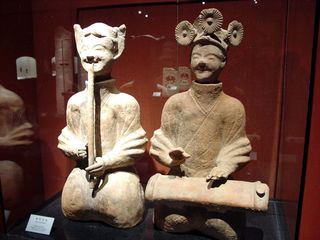
Music of China refers to the music of the Chinese people, which may be the music of the Han Chinese as well as other ethnic minorities within mainland China. It also includes music produced by people of Chinese origin in some territories outside mainland China using traditional Chinese instruments or in the Chinese language. It covers a highly diverse range of music from the traditional to the modern.
Different types of music have been recorded in historical Chinese documents from the early periods of Chinese civilizationwhich, together with archaeological artifacts discovered, provided evidence of a well-developed musical culture as early as the Zhou Dynasty (1122 BC – 256 BC). These further developed into various forms of music through succeeding dynasties, producing the rich heritage of music that is part of the Chinese cultural landscape today. Chinese music continues to evolve in the modern times, and more contemporary forms have also emerged.
According to legends, the founder of music in Chinese mythology was Ling Lun who, at the request of the Yellow Emperor to create a system of music, made bamboo pipes tuned to the sounds of birds including the phoenix. A twelve-tone musical systemwas created based on the pitches of the bamboo pipes, the first of these pipes produced the "yellow bell" (黃鐘) pitch, and a set of tune bells were then created from the pipes.
Traditional MusicNational Music
Guoyue
The term guoyue, or national music, became popular in the early 20th century and was used loosely to include all music written for Chinese instruments in response to a particular nationalistic consciousness. The term however may have a slightly different meaning when used by different Chinese communities. It was originally used only referred to the music of the Han Chinese; it later began to include music of various ethnic minorities in China. In the Republic of China in Taiwan, Guoyue emphasized music of the mainland China over the Taiwanese local traditions. In mainland China a new term minyue (民乐, short for minzu yinyue or "people's music") was coined post-1949 in place of guoyue to encompass all compositions and genres for traditional instruments. In other Chinese communities, it may also be referred to as huayue (for example in Singapore) or zhongyue (in Hong Kong).
Instrumental
Traditional Chinese musical instruments
Musical instruments were traditionally classified into 8 categories known as bayin. Traditional music in China is played on solo instruments or in small ensembles of plucked and bowed stringed instruments, flutes, and various cymbals, gongs, and drums. The scale is pentatonic. Bamboo pipes and qin are among the oldest known musical instruments from China; instruments are traditionally divided into categories based on their material of composition: animal skins, gourd, bamboo, wood, silk, earth/clay, metal, and stone. Chinese orchestras traditionally consist of bowed strings, woodwinds, plucked strings and percussion.
Instruments
Woodwind and percussion: dizi, suona, sheng, paigu, gong, paixiao, guan, bells, cymbals, hulusi
Bowed strings: erhu, zhonghu, dahu, banhu, jinghu, gaohu, gehu, yehu, cizhonghu, diyingehu, leiqin
Plucked and struck strings: guqin, sanxian, yueqin, yangqin, guzheng, ruan, konghou, liuqin, pipa, zhu
Listening Examples
Music of China Listening Practice
|
| ||||||||||||

